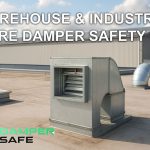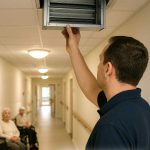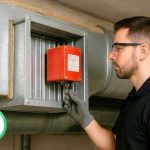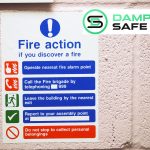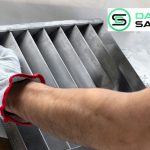Common Fire Damper Failures and How to Prevent Them
 Introduction: Why Fire Damper Maintenance Matters
Introduction: Why Fire Damper Maintenance Matters
Fire dampers are critical safety components designed to stop fire and smoke from spreading through ductwork. However, even the best installations can fail if not maintained properly. Across the UK, fire damper failures continue to appear in compliance audits — often due to simple oversights such as blocked access, corrosion, or missed inspections.
In this guide, the experts at Damper Safe Ltd explain the most common causes of fire damper failures and, more importantly, how to prevent them through proper maintenance, access, and testing.
1. Blocked or Inaccessible Fire Dampers
One of the most frequent causes of fire damper failures is poor accessibility. Many dampers are installed in awkward or hidden locations within ceilings or walls. Over time, these areas can become obstructed by building modifications, cabling, or insulation, preventing technicians from performing inspections or tests.
To avoid this, it’s essential to ensure that all dampers are fitted with properly sized access panels, clearly labelled, and free from obstruction. The DW145 Fire Damper Standard provides clear guidance on access requirements and good practice for positioning.
2. Corrosion and Environmental Damage
Another leading cause of fire damper failures is corrosion. Damp or humid environments, especially in basements or plant rooms, can cause the metal components of a fire damper to deteriorate over time. Rusted blades, hinges, and springs may fail to close when triggered, rendering the damper useless during a fire.
Preventative measures include using corrosion-resistant materials, performing regular cleaning, and ensuring that ventilation systems are free from condensation build-up. During fire damper testing, qualified engineers can identify early signs of corrosion and recommend remedial work before failure occurs.
3. Poor Installation or Misalignment
Even with high-quality products, improper installation can result in significant fire damper failures. Misaligned blades, missing screws, or faulty actuators can all prevent a damper from closing correctly. This is particularly common in older buildings or retrofits where ductwork has been modified.
To prevent installation-related failures, all dampers should be fitted and commissioned in accordance with Fire Damper Installation Best Practices (UK). Professional inspection following installation is equally vital to verify performance and ensure regulatory compliance.
4. Lack of Routine Testing and Maintenance
Failing to perform routine testing remains one of the most serious causes of fire damper failures. According to UK law, all fire dampers must be inspected and tested at least once every 12 months — and more frequently in high-risk environments such as hospitals or care homes.
Without scheduled maintenance, dirt, debris, or mechanical fatigue can prevent proper operation. Engaging a qualified provider like Damper Safe Ltd ensures that every damper is tested, documented, and compliant with UK safety standards.
For detailed information on testing intervals and budgeting, read our blog Fire Damper Testing Costs Explained: Budgeting for Compliance.
5. Damaged Fusible Links or Actuators
Mechanical failure of fusible links or actuators is another common reason for fire damper failures. Over time, these components can become clogged with dust, coated in grease, or simply worn out. When the temperature rises during a fire, a damaged link may not release properly — preventing the damper from closing.
Regular inspection by a competent engineer is the only reliable way to identify defective components. During fire damper testing, all moving parts and links are manually operated, lubricated, and replaced where necessary to maintain full functionality.
6. Absence of Accurate Asset Registers
In many facilities, fire damper failures occur not because of mechanical issues, but due to poor documentation. Without an accurate asset register, some dampers may be forgotten entirely — left untested for years or buried behind construction works.
Creating a complete digital register of every damper location, type, and access route helps ensure that nothing is missed during annual testing. Damper Safe Ltd provides clients with full asset mapping and photographic evidence after each inspection for complete transparency.
How to Prevent Fire Damper Failures
Preventing fire damper failures starts with a proactive, evidence-based maintenance plan. Here’s what every facility should include:
- Annual testing in line with DW145 and BS 9999 standards.
- Proper access panel installation and labelling for every damper.
- Regular cleaning to remove dust and debris from fusible links and blades.
- Routine visual inspections to identify corrosion or physical damage.
- Comprehensive documentation and asset registers for traceability.
By implementing these preventative measures, you can drastically reduce the risk of fire damper failures and maintain a safe, compliant building.
Professional Fire Damper Testing and Maintenance
If your building hasn’t had a recent inspection or you suspect issues with damper accessibility, now is the time to act. At Damper Safe Ltd, we provide nationwide fire damper testing services, remedial works, and full compliance reporting.
We work across sectors — from hospitals and schools to warehouses and office buildings — ensuring that every damper is safe, operational, and legally compliant.
Conclusion: Prevention Is Always Better Than Cure
Fire damper failures are preventable when backed by regular maintenance, good access, and expert testing. Ignoring these systems can put lives at risk and expose property owners to serious legal consequences.
Working with professionals such as Damper Safe Ltd ensures that your fire dampers remain functional, compliant, and ready to protect your building when it matters most.
For official fire safety maintenance advice, see the UK Government’s Fire Safety Responsibilities Guide.



